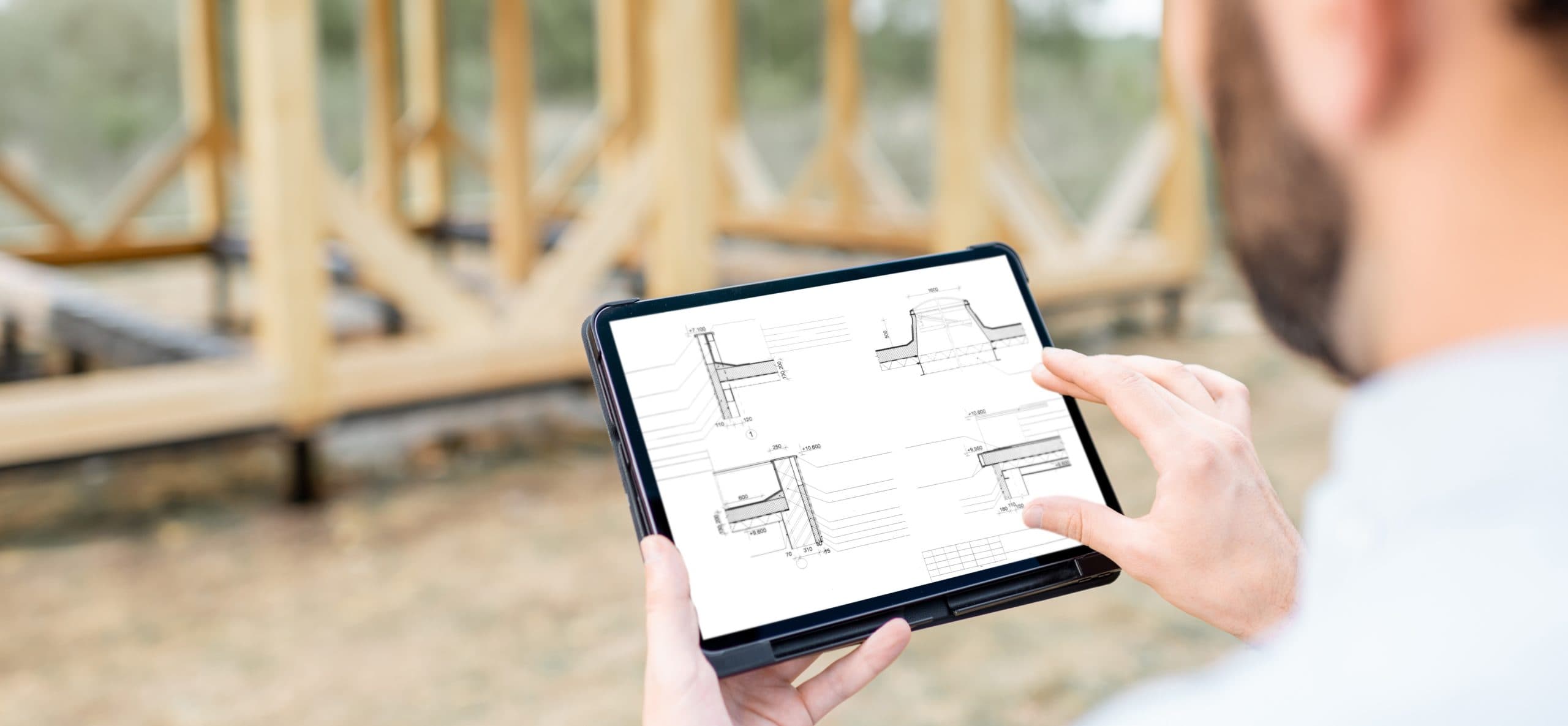The Development of New Processes and Programs is Picking up Speed in Germany
Digital processes and tools are changing all areas of our lives at a rapid pace. However, digitalisation in the construction industry is developing more slowly than in other industries. This may be because working with soil, stone, steel and concrete is so analog. In any case, this is certain: Digitization on the building site and in the offices for planning and administration must and will progress faster.
This is also because, for example, the use of the digital application “Building Information Modeling” (BIM) will be mandatory for public infrastructure projects in Germany from this year onwards. In our article, we have already described 20 construction industry trends to watch in 2020.Today we’re taking a closer look at this topic and reveal other aspects of the digitalization in the construction industry in Germany.
Important Topics of Digitization in the Construction Industry
PropTech
PropTech companies (Property Technology) are often startups in the construction industry that develop or optimize products and services for the real estate industry, including construction and management. With the latest information and communication technologies, business processes and business models have become more efficient or even completely new ones are developed. They aim to achieve higher performance, ultimately leading to greater cost efficiency.
The services and products of PropTechs cover the complete life cycle of a property: from financing and realization to subsequent operation and utilization through rental or resale.
Machine Learning
Increasingly, artificial intelligence (AI) is ensuring greater efficiency and safety in construction while reducing costs at the same time – both in planning and on the construction site. Machine learning allows IT systems to improve themselves by independently “learning” from data using statistical methods. The mathematical methods of pattern recognition used for this purpose allow the machine to gain more and more knowledge of its field of activity and to implement it more effectively.
Artificial Intelligence
In general, artificial intelligence (AI) will positively change all areas of the construction industry. AI will open up completely new opportunities in many areas that are still difficult to control today. For example, for automated construction planning, an automated comparison of similar projects can lead to software-generated recommendations for decisions in the current construction process. And included current weather data or delivery dates of components can influence the daily planning. Safety at the dangerous workplace “construction site” – with a fatal accident rate five times higher than in any other industry – will also increase.
3D Printing
In 2004, the University of South Carolina succeeded in building a wall only using 3D printing for the first time – today a house can be printed in 20 hours. Back then, a robot arm applied layers of concrete instead of plastic. The advantages: Reduced costs and waste, faster construction speed, reduced accidents, construction of complex architectural shapes and much more.
Robotics and Automation
Higher quality through automation: Experiments with construction site robots have been going on since the 1970s. And in Japan and Korea, they have actually been active in building construction since the 1980s. Robotic systems can now make entire skyscrapers grow out of the ground, and research is continuing steadily.
Internet of Things (IoT)
The Internet of Things (IoT) is changing the process of digitization in the construction industry, especially in the area of employee security. RFID solutions, for example, warn of dangerous approach of reversing machines. And wearables monitor employees’ heart rates and body temperatures to prevent overexertion and provide recommendations for action.
But the entire management of construction sites is also simplified by equipping construction sites with IoT sensors. Above all, costs are reduced through predictive maintenance and more efficiently controlled systems.
Digitization on Site: New Tools for the Construction Site
 BIM: Digital Forward Planning
BIM: Digital Forward Planning
Planning, designing, constructing and managing buildings – digitally, quickly, with foresight and therefore more effectively than ever before: Building Information Modeling (BIM) makes it possible. The idea of Building 4.0 is to significantly reduce costs and risks already during the planning and construction process; because from a grain of sand to the finished skyscraper, all steps in the construction process are linked together and mapped in a digital chain. This means that potential problems and conflicts can already be identified in the digital twin of the planned construction project, which are then immediately solved digitally. This error can thus be avoided immediately on the actual construction site.
From the first phase, BIM brings together all the trades involved, which communicate with each other using a shared digital 3D model and track all project progress in real time. From the architect to the construction company to the owner, everyone has simultaneous access to identically up-to-date data and drawings, from which service providers involved in the maintenance of the building can also benefit later on.
Many offices still shy away from the high costs of BIM software. But in the near future the advantages will outweigh the costs. In the step-by-step plan “Digital Planning and Construction”, which was presented as early as 2015, the Federal Ministry of Transport and Digital Infrastructure (BMVI) formulated the goal of using BIM throughout the country for future federal infrastructure projects.
Automation on Construction Sites and in Prefabrication
While BIM tends to play a role behind the visible scenes, the digitalization of the construction industry will also lead to completely new visible scenarios: Construction sites with self-propelled machines, 3D printers and partially automated concrete distributors. In addition, surveying even hard-to-reach areas with drones and small satellites will become easier. And digitally networked equipment, components and early warning systems ensure efficient daily operations.
The prefabrication of building elements is also very much in line with digitalization in the construction industry. To ensure that the integration of building services in walls and ceilings is perfectly successful, experts from all disciplines work together and produce complex areas of a building entirely in the factory.
3D Printing for Completely New Processes
A lot has happened since the beginnings in 2004. Today, there are several processes that use, for example, a mix of concrete and glass fibres and possibly apply a polymeric foam for insulation at the same time. It is also possible to print stable metal structures in stainless steel, bronze, aluminium and Inconel alloys.
Part of the international research experts is also a team from the Technical University of Dresden. Within the framework of the “Concrete 3D Printing” project, this team is working on a technology with which fresh concrete can be applied directly on the construction site without the need for formwork. Due to the numerous promising developments, the concrete market for 3D printing is expected to reach 50 million euros by 2021.
Visualizing the Future Today with VR (Virtual Reality)
Technologies such as virtual reality or augmented reality provide great relief on several levels, as they enable visualizations that bring more transparency. Even during the planning phase of a construction project, VR glasses show the effects of the project on the environment under real conditions. This allows residents to experience the future even before the construction project has started. This increases transparency and acceptance.
Software for the Construction Industry
Electronic Accounting System
Modern invoicing programs simplify the process from quotation to invoicing. If your customer has accepted the offer, the program converts it into an invoice immediately after the project is completed. And: The program will tell you which invoices are due and, if required, will generate a payment reminder immediately.
Tendering Platforms
Software-supported tendering platforms set new standards with regard to optimized processes. Here, too, artificial intelligence plays the decisive role. The various groups of interested parties in the construction industry only have to communicate their requirements for the projects, then the software automatically provides them with relevant projects. Building Radar is one of the digital platforms that brings together project initiators and suppliers as well as service providers using AI. This tool for automated project research fills the postbox of searchers – who only have to view and select the projects received – thanks to customizable and thus very precisely adjustable filter functions. In this way, the decisive early contact can be established with minimal effort.
Tender Management
Construction projects are complex – sophisticated software simplifies and accelerates the processes. This also applies to participation in tenders. The spectrum ranges from preparing the cost estimate and the bill of quantities to processes for subsequent contract award and the ongoing project. This makes it possible to practice smart cost management at all levels. This works, for example, with the AVA software ORCA AVA, with which you can accompany any number of construction projects of any size and with cost planning according to DIN 276-2018.
Enterprise Resource Planning (ERP)
As soon as processes can be standardized, their support by software is the next logical step. This also applies to the control of numerous business processes in companies. Process acceleration is called Enterprise Resource Planning, or ERP for short. An ERP system optimizes organizational structures and processes and increases the company’s ability to adapt to changes in the market or in its customer base. The system helps to structure and monitor all relevant processes and is thus the central management tool for business management control. An ERP system is staffed with subsystems, so-called modules, depending on individual requirements. By accessing a module, for example, employees feed in data which is then used by other employees. This streamlines numerous processes and increases their quality.
Summary on the Digitalization of the Construction Industry in Germany
Digitization in Germany has indeed picked up speed and the necessary investments are increasing. Business processes are also being increasingly digitized. Nevertheless, there is still plenty of room for improvement compared to other industries. But the now unmistakable compulsion to digitize goes hand in hand with the “reward” that is already visibly to be expected: The demand for good apartments and houses has rarely been as great as it is now, and yet there is far too little affordable housing available. More and more people are moving to the conurbations, while people on low incomes are being driven from the inner cities to the outskirts.
The construction industry is not lagging behind with its current procedures and working methods. Accelerating construction by increasing efficiency therefore solves many problems and increases the profits of the companies involved. Here too, there are more opportunities than risks for your company. As soon as you overcome the role of the runner-up on the path that has already begun systemically and become a shaper instead.


 BIM: Digital Forward Planning
BIM: Digital Forward Planning







